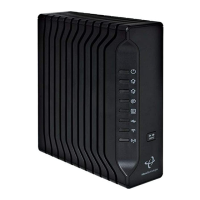79
HITRON CGNV2 USER’S GUIDE
WIRELESS
WEP (the Wired Equivalency Protocol): this protocol uses a series of “keys” or
data strings to authenticate the wireless client with the AP, and to encrypt data
sent over the wireless link. WEP is a deprecated protocol, and should only be
used when it is the only security standard supported by the wireless clients.
WEP provides only a nominal level of security, since widely-available software
exists that can break it in a matter of minutes.
WPA-PSK (WiFi Protected Access - Pre-Shared Key): WPA was created to
solve the inadequacies of WEP. There are two types of WPA: the “enterprise”
version (known simply as WPA) requires the use of a central authentication
database server, whereas the “personal” version (supported by the CGNV2)
allows users to authenticate using a “pre-shared key” or password instead.
While WPA provides good security, it is still vulnerable to “brute force”
password-guessing attempts (in which an attacker simply barrages the AP with
join requests using different passwords), so for optimal security it is advised that
you use a random password of thirteen characters or more, containing no
“dictionary” words.
WPA2-PSK: WPA2 is an improvement on WPA. The primary difference is that
WPA uses the Temporal Key Integrity Protocol (TKIP) encryption standard
(which has been shown to have certain possible weaknesses), whereas WPA2
uses the stronger Advanced Encryption Standard (AES) in the Counter mode
with Cipher block chaining Message authentication code Protocol (CCMP),
which has received the US government’s seal of approval for communications
up to the Top Secret security level. Since WPA2-PSK uses the same pre-shared
key mechanism as WPA-PSK, the same caveat against using insecure or
simple passwords applies.
6.3.2 OTHER WIRELESS CONCEPTS
This section provides information on wireless-related topics not covered in previous
sections.
6.3.2.1 WPS
WiFi-Protected Setup (WPS) is a standardized method of allowing wireless devices
to quickly and easily join wireless networks, while maintaining a good level of
security. The CGNV2 provides two methods of WPS authentication:
Push-Button Configuration (PBC): when the user presses the PBC button on
the AP (either a physical button, or a virtual button in the GUI), any user of a
wireless client that supports WPS can press the corresponding PBC button on
the client within two minutes to join the network.
Personal Identification Number (PIN) Configuration: all WPS-capable
devices possess a PIN (usually to be found printed on a sticker on the device’s
housing). When you configure another device to use the same PIN, the two
devices authenticate with one another.
Once authenticated, devices that have joined a network via WPS use the WPA2
security standard.

